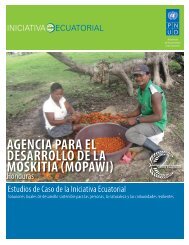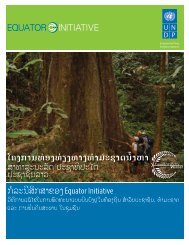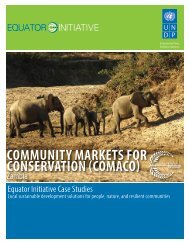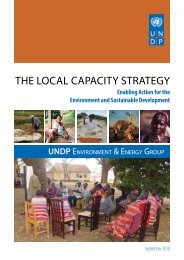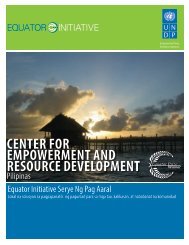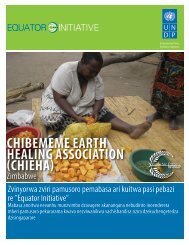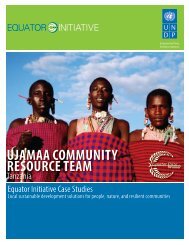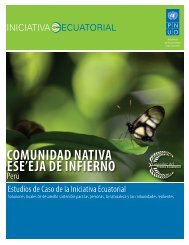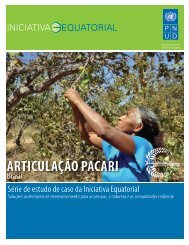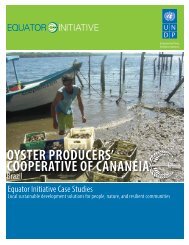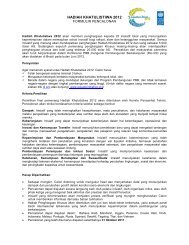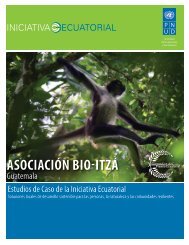INDIGENOUS TOURISM NETWORK OF MEXICO - Equator Initiative
INDIGENOUS TOURISM NETWORK OF MEXICO - Equator Initiative
INDIGENOUS TOURISM NETWORK OF MEXICO - Equator Initiative
You also want an ePaper? Increase the reach of your titles
YUMPU automatically turns print PDFs into web optimized ePapers that Google loves.
Through workshops, RITA emphasizes the importance of the measurement<br />
and monitoring aspects of its work, which involve systematizing<br />
and preparing relevant reports to present to the Council<br />
level of companies or communities in order to take any necessary<br />
actions. Each tourism microenterprise formulates its own monitoring<br />
and measurement system in accordance with the surrounding<br />
environment, using traditional indigenous methods to measure the<br />
biodiversity impacts of their work.<br />
Some RITA microenterprises have also partnered with the Mexican<br />
government in the conservation of biodiversity. An example is<br />
the co-administration of the caves of Cacahuamilpa. The government,<br />
represented by the National Commission of Protected Areas<br />
(CONANP), joined together with people from surrounding communities<br />
and succeeded in generating the income necessary to improve<br />
the quality of life in the region and improve the care of the local environment,<br />
including these caves. Another example is Xochimilco<br />
Biological Station which deals with the conservation of the axolotl,<br />
a species endemic to the channels of the lake region of Mexico City.<br />
SOCIOECONOMIC IMPACTS<br />
RITA aims to improve the lot of indigenous communities by generating<br />
permanent employment for indigenous people. When RITA<br />
was established in 2002, the 32 microenterprises that comprised the<br />
network had poor infrastructure and were not operating to their fullest<br />
potential. With RITA’s assistance, they have been able to develop<br />
projects that provide a range of integrated services such as cabanas,<br />
restaurants, trails and saunas, resulting in increased income to members<br />
companies.<br />
The development of tourism initiatives reduced communities’ dependence<br />
on agricultural uses of the land, which traditionally provide<br />
unsteady incomes, with little or no income in the off-season.<br />
RITA’s assistance in creating and developing projects within these<br />
communities has provided a steady source of income beyond the<br />
minimum wages in respective regions.<br />
RITA’s 160 member microenterprises currently employ approximately<br />
5,000 people. Assuming four members per family, this employment<br />
supports approximately 20,000 people. In this way, the indigenous<br />
communities associated with RITA have benefitted greatly<br />
from their involvement in the network.<br />
RITA’s level of inclusion is to be commended, and ensures that the<br />
benefits of its projects are shared as widely as possible in the communities<br />
it works with. Overall, approximately 1,500 women are<br />
beneficiaries of the initiative. Some companies are fully comprised<br />
of women, such as la Masehual Siuame de Puebla, Flowers of the<br />
Amuzga Land of Xochistlahuaca in Guerrero, and the Mayan Women<br />
of Jovel of San Cristóbal. RITA’s three-year work plans are approved<br />
by members, and regular meetings with the various indigenous<br />
groups are held to share experiences and work methods, ensuring<br />
that all members’ voices are heard.<br />
Secondary benefits<br />
In addition to improving the economic welfare of its members and<br />
their wider, RITA’s work has also resulted in secondary benefits. Development<br />
can be seen in personal projects aimed at identifying<br />
leadership capacity in the region. For example, youth are already<br />
playing a part in the conservation movement.<br />
Further secondary benefits of RITA’s work can be seen in the work<br />
of several specific microenterprises. For example, in Guerrero, programs<br />
have been established that allow for some of the revenue<br />
from the Cacahuamilpa grottos project to be directed towards improvements<br />
in the infrastructure of the four neighboring communities.<br />
These funds have been used to provide support to schools,<br />
improve medical services, and pay for paving and sewage systems.<br />
Similarly, in Nuevo San Juan Parangaricutiro in Michoacan, there has<br />
also been investment of income to community services in the municipality.<br />
In Capulálpam de Mendez in Oaxaca, the management of<br />
the community’s resources resulted in its acceptance into the Federal<br />
Tourism Ministry’s ‘Magical Towns’ program, a program created<br />
to preserve and promote the culture, ecology and history of towns<br />
9



